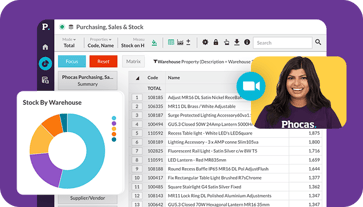How to present financial statements to different audiences
Communicating financial statements effectively is one of the most important responsibilities for finance professionals. Whether you're advising the sales team or preparing updates for board members, you need to meet them where they are. Financial reporting is about ensuring your stakeholders can understand the company’s financial position, profitability and overall financial performance.
In this blog, we’ll explore how to present financial information clearly to audiences. We’ll cover techniques for turning complex financial data into digestible highlights, outline best practices for financial presentations and share takeaways for making sure your message resonates.
Clear statements work best
Financial statements like the income statement (profit and loss), balance sheet and cash flow statement are central to communicating a company’s financial health. Yet these can often be a wall of numbers or lots of information spread across many tabs or spreadsheets. When that happens, audiences may miss the bigger picture of what is going on.
Board of directors need clarity to evaluate financing activities and the long-term strategy. Whereas sales teams rely on sales versus budget results and key metrics about people and products to guide decision-making. Purchasing leaders depend on accurate financial reporting to communicate performance with suppliers.
Ultimately, clear financial presentations lead to informed decisions and stronger confidence in the company’s financial planning.
The three key financial statements
When preparing a presentation, you’ll likely use one of the three major financial statements, the income statement (profit and loss statement), balance sheet and cashflow statement. The income statement (profit and loss statement) shows a company’s revenue, gross profit, cost of goods sold (COGS) and net income. It helps audiences understand profitability and trends over time.
In the Phocas Financial Statements product users can change the standard view of a financial statement to suit specific analysis and reporting needs. This is a great resource to help communicate effectively with different audiences.
You can change the financial statements to suit the set-up of your business. And the best part is, no matter what changes you make there is no change of the source data in your ERP system. When you set up a financial statement in a particular way, if you switch to another income statement for say a sales division, the view is applied to that statement too. For example, your organization might have multiple versions of the profit and loss statement and you can use the same base for each audience or also change according to what you’re trying to communicate.
The balance sheet summarizes assets, liabilities and equity. It provides a snapshot of financial position at a point in time, including accounts receivable and accounts payable.
The Phocas balance sheets are flexible and users can incorporate specific KPIs into them. Typical calculations and KPIs our customers like to build include ratio formulas for the quick ratio, cash ratio, working capital, debt, debt/equity, return on assets and return on equity. For those who have inventory they use days sales outstanding, days sales of inventory and days payable outstanding and cash conversion cycle using the custom calculation tools. The software also has KPI template reports that you can create for each audience and extend the use of the balance sheet to suit their needs.
A cashflow statement breaks down cash inflows and outflows across operating, investing and financing activities. This is vital for explaining liquidity and whether the company can meet obligations. These provide a holistic view of a company’s financial performance. In Phocas the cash flow statement is derived from the income statement (profit and loss) amounts and movements in the Balance Sheet for the selected period. General ledger accounts can only be mapped to one group, which makes the direct method cashflow presentation easier to achieve.
Making financial information accessible
Everyone appreciates clarity so to make the financial data accessible, it’s a good idea to simplify the language. Instead of bombarding people with all the accounting terms help educate your audience with plain English examples where possible. Rather than write 'EBITDA margins expanded' (earnings before income tax, depreciation and amortization), you might want to write or say, 'profitability from core business activities improved this quarter'. As the months progress, you can build more learning into your descriptions based on engagement and what colleagues are communicating back to you. Finance teams can also learn the language of other departments and incorporate them.
Use graphs, charts and dashboards wherever you can because these tools are great to show trends. A line chart of net income growth is often more impactful than a table.
Reusing templates also helps to build familiarity for stakeholders receiving regular reports each month or week.
Ensuring clarity doesn’t mean ignoring accounting standards. All financial reports can be both compliant and contain improved formats for better understanding.
Using storytelling in financial presentations
Financial presentations resonate more when they're framed as stories. For example, when showing cost of goods sold see if you can connect the figures to any specific efficiency initiatives that have improved gross profit.
While presenting forecasts, outline the drivers that are being used to create new scenarios and their impact on the company’s financial performance.
This narrative approach helps your audience understands the numbers and your company’s financial health in context.
Here are some suggested rules for presenting financial statements clearly
-
Always tailor your presentation to the audience.
-
Use templates, dashboards and graphs to make financial data accessible and to build familiarity.
-
Focus on key metrics and financial ratios that are useful for the audience.
-
Provide examples and clear explanations of findings for quick understanding.
-
Maintain compliance with accounting standards while keeping language clear and approachable.
By turning financial data into stories, using visual aids and focusing on key metrics, you can help stakeholders understand the company’s financial health and make informed decisions.
Clear financial statements are about communication. A balance sheet, income statement or cash flow statement may contain all the right numbers but unless those numbers are framed in a way that resonates with the audience, the message can get lost. Tools like Phocas Financial Statements make a real difference because finance teams can use familiar templates enhanced with metrics, visual aids and dashboards. By presenting financial information in a way that matches the needs of the audience, finance leaders show they care. This detail also helps to build trust and more buy-in to how everyone's work is contributing to the overall success of your business.


Katrina is a professional writer with a decade of experience in business and tech. She explains how data can work for business people and finance teams without all the tech jargon.
Related blog posts
If you’re nodding along to this headline, you’re probably interested in finding out how this process can be made reliable and repeatable. Many finance teams need spreadsheets, email trails and offline files to make critical adjustments before reports are ready for the business. It works until it doesn’t. As complexity grows, the gap between your ERP and the final ‘true’ management view widens.
Read more
Intercompany journals are like transferring stock between two warehouses in the same distribution group. One warehouse records inventory going out at as an internal transfer price, and the other records it coming in. The group hasn’t gained or lost anything — it’s just tracking the internal movement.
Read more
Financial planning and analysis (FP&A) provides the insights that drive growth, protect profitability and guide new investments. Done well, FP&A transforms raw financial data into scenario models and forecasts, helping finance leaders and business units move ahead with confidence.
Read moreBrowse by category

Find out how our platform gives you the visibility you need to get more done.
Get your demo today